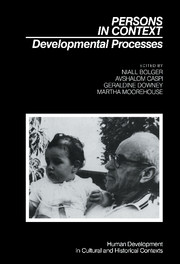Book contents
- Frontmatter
- Contents
- Preface
- Contributors
- 1 Development in context: research perspectives
- 2 Interacting systems in human development Research
- 3 Children, families, and communities: ways of viewing their relationships to each other
- 4 Human development and social change: an emerging perspective on the life course
- 5 Family process: loops, levels, and linkages
- 6 On the constructive role of problem behavior in adolescence
- 7 The sociogenesis of self concepts
- 8 Putting persons back into the context
- 9 How genotypes and environments combine: development and individual differences
- Author index
- Subject index
6 - On the constructive role of problem behavior in adolescence
Published online by Cambridge University Press: 04 May 2010
- Frontmatter
- Contents
- Preface
- Contributors
- 1 Development in context: research perspectives
- 2 Interacting systems in human development Research
- 3 Children, families, and communities: ways of viewing their relationships to each other
- 4 Human development and social change: an emerging perspective on the life course
- 5 Family process: loops, levels, and linkages
- 6 On the constructive role of problem behavior in adolescence
- 7 The sociogenesis of self concepts
- 8 Putting persons back into the context
- 9 How genotypes and environments combine: development and individual differences
- Author index
- Subject index
Summary
Introduction
Is substance use good for adolescents? This chapter demonstrates that a simple “no” may obscure the intricate ways in which problem behaviors and normal, adaptive adolescent development are intertwined.
In making the transition from childhood to adulthood, adolescents face a variety of demands and challenges and they must acquire appropriate skills to master these challenges. Resorting to problem behavior such as substance use may be viewed as one way of mastering the developmental difficulties of adolescence. This postulated connection between the typical problems adolescents face and problem behaviors leads us to expect a sharp, but temporary, increase in substance use during this period of the life span. Indeed, prospective longitudinal studies have documented that the increase in substance use in adolescence is transient (Huba & Bentler, 1983; Jessor, 1986; Kandel & Logan, 1984; Magnusson, Duner, & Zetterboom, 1975).
Our perspective on adolescence highlights the constructive function of problem behavior in coping with age-typical demands and difficulties. We do not, of course, dismiss the health and psychological risks resulting from the use of legal and illegal substances. Rather, we propose that young people's problem behaviors can be understood adequately only in the broader context of normal adolescent development. In this chapter we first outline a conceptual framework linking adolescent development and problem behavior. We have referred to this framework as “development as action in context” (Silbereisen & Eyferth, 1986).
- Type
- Chapter
- Information
- Persons in ContextDevelopmental Processes, pp. 152 - 180Publisher: Cambridge University PressPrint publication year: 1989
- 9
- Cited by

